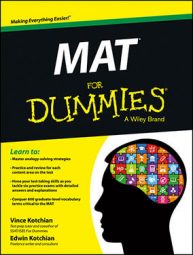Preparing for the Millers Analogies Test (MAT) is an active process, which should include taking practice tests: Not only do the MAT practice tests help you set a reasonable benchmark for your studies, they help you pinpoint your weaknesses and the areas you need to concentrate on the most.
You can purchase practice tests online at the official Miller Analogies Test website. You can also register to take the official test there when you’re ready.
Take the official MAT tests toward the end of your preparation. You’ll get more out of them once your skills are at their peak. And, retake the one you took initially for extra practice.
Time your MAT practice work
When you’re ready to start taking MAT practice tests in earnest, here’s a helpful tip: Take the first one or two tests untimed. If you really want to record your time during your first practice test, go ahead, to build time awareness, but don’t worry too much about how long it takes. At this point, building skill is the primary goal. Speed comes with skill.
Of course, after a couple untimed practice tests, you need to start timing yourself. When you’re taking a timed test, remember a few points:
Know how many questions you can ignore for your goal. Unless you’re shooting for a perfect score or close to it, you shouldn’t be spending time working on every question, so that you buy yourself more time to get the questions right that you’re good at. Quickly guess on harder questions, and know about how many questions you can do this with.
Don’t rush. Never sacrifice your technique for speed. Your goal on the MAT is to get the questions right that you spend time on.
Keep question difficulty in mind. The questions generally get harder as the test goes on. So don’t stress out if you don’t finish on time — the questions you didn’t get to were probably the hardest ones.
There’s no penalty for guessing – so don’t let the test end without at least guessing on every question. Also, do leave a couple minutes at the end of the test to quickly guess on any skipped questions.
Duplicate the MAT test environment
When you take the real MAT, you’ll likely be in a quiet room, alone or with other test takers. In the testing environment, you’ll experience no pauses, few to no distractions, and lots of heavy silence. In preparing for the test, it’s a great idea to get used to testing in this kind of environment.
For instance, you’ll definitely be sitting at a desk with a straight-backed chair. If you take all your practice tests out on the patio on a chaise lounge with the wind softly caressing your face and a tall glass of iced tea at your elbow, the environment of a typical MAT testing center may feel uncomfortable.
Take a few tests in a quiet, isolated room with no distractions. Library study rooms can be good for this type of practice, but any quiet setting in which no one can disturb you works fine. Practicing in this setting will make the real testing environment feel more natural.
Take several practice tests
Within reason, it’s a good idea to take several practice MATs before you attempt the real thing. The best practice tests are the official tests available for purchase from the MAT website, simply because they’re written by the same people who wrote the MAT that you’ll officially take. Buying all three of these tests is absolutely worth it because they expose you to the maximum number of real MAT questions.
Spend a good deal of your time working with the real MAT tests, either alone or with a tutor, because they’re as close as you can get to the real thing. Unfortunately, the MAT provides only three tests for purchase, so you’ll want to supplement them with the practice tests you find elsewhere.
Taking several tests is also important because you see many different questions and content angles. But a quick word or warning is in order: You want to focus on quality practice, not quantity. You can learn a lot from each practice test you take. Make sure you analyze your mistakes and understand why you missed those questions before you plunge into another new test.
Also analyze the questions you guessed on — even those you guessed correctly — to ensure that you understand the best way to answer those items.
Know when you’re ready to register for the MAT
If you’re applying to graduate school, you may have an admissions deadline. To register for the MAT, you’ll need to call one of the testing centers on Miller Analogies website.
Before you register, check with both the testing center and the programs to which you’re applying to find out how long it usually takes for the program to receive the official MAT score. Be sure to allow enough time for the score to reach your program(s).
If your test date is more flexible, you’ll need to decide when to register. To be sure you’re ready, you’ll want to have achieved your goal score on one of the official MAT practice tests, when taken timed. Don’t register until you’ve proven to yourself that you can achieve your goal.
As you take practice tests and score them, you’ll get valuable data about your ability. If your scores are increasing according to your study plan, the test date you registered for may make sense. If not, you may want to push back your test date, to give yourself more time to improve.
Make sure you check directly with your testing center to learn about its policies for changing your test date (including any fees that may be involved).

